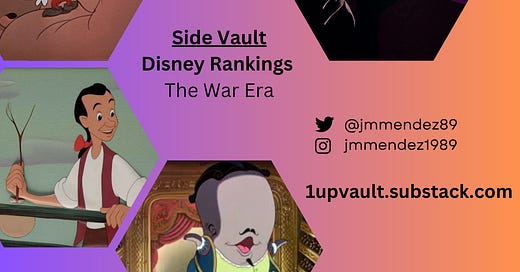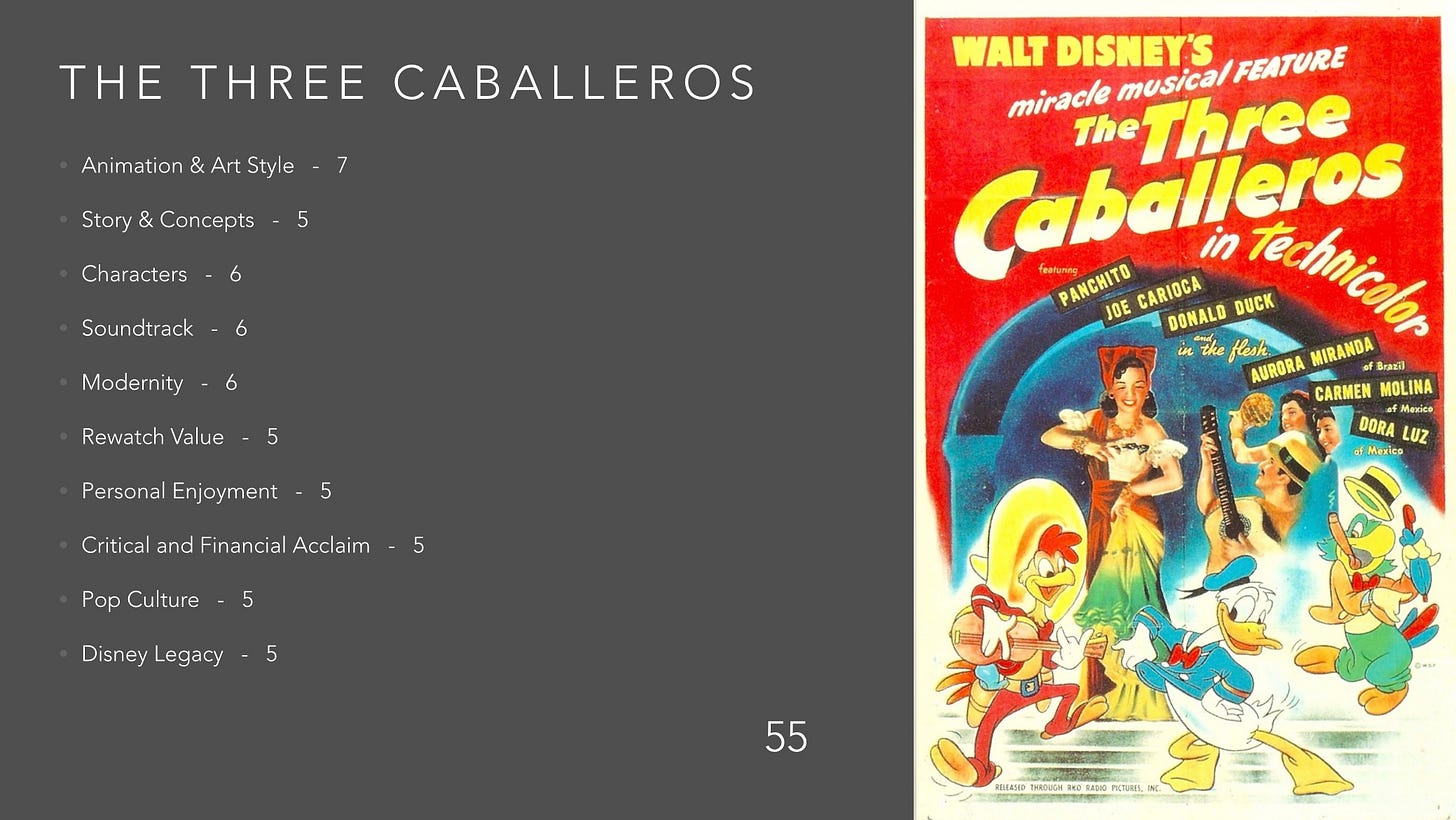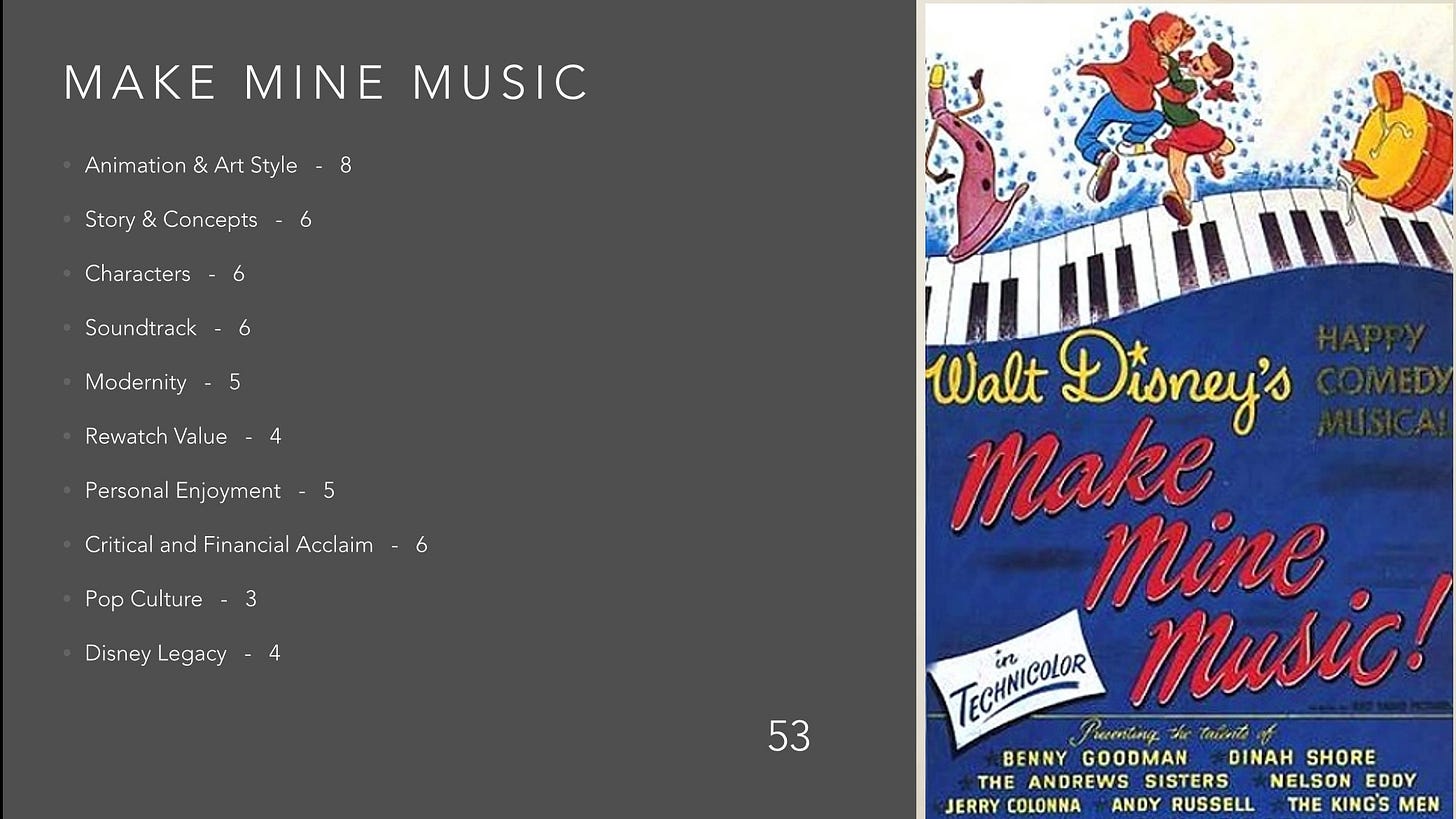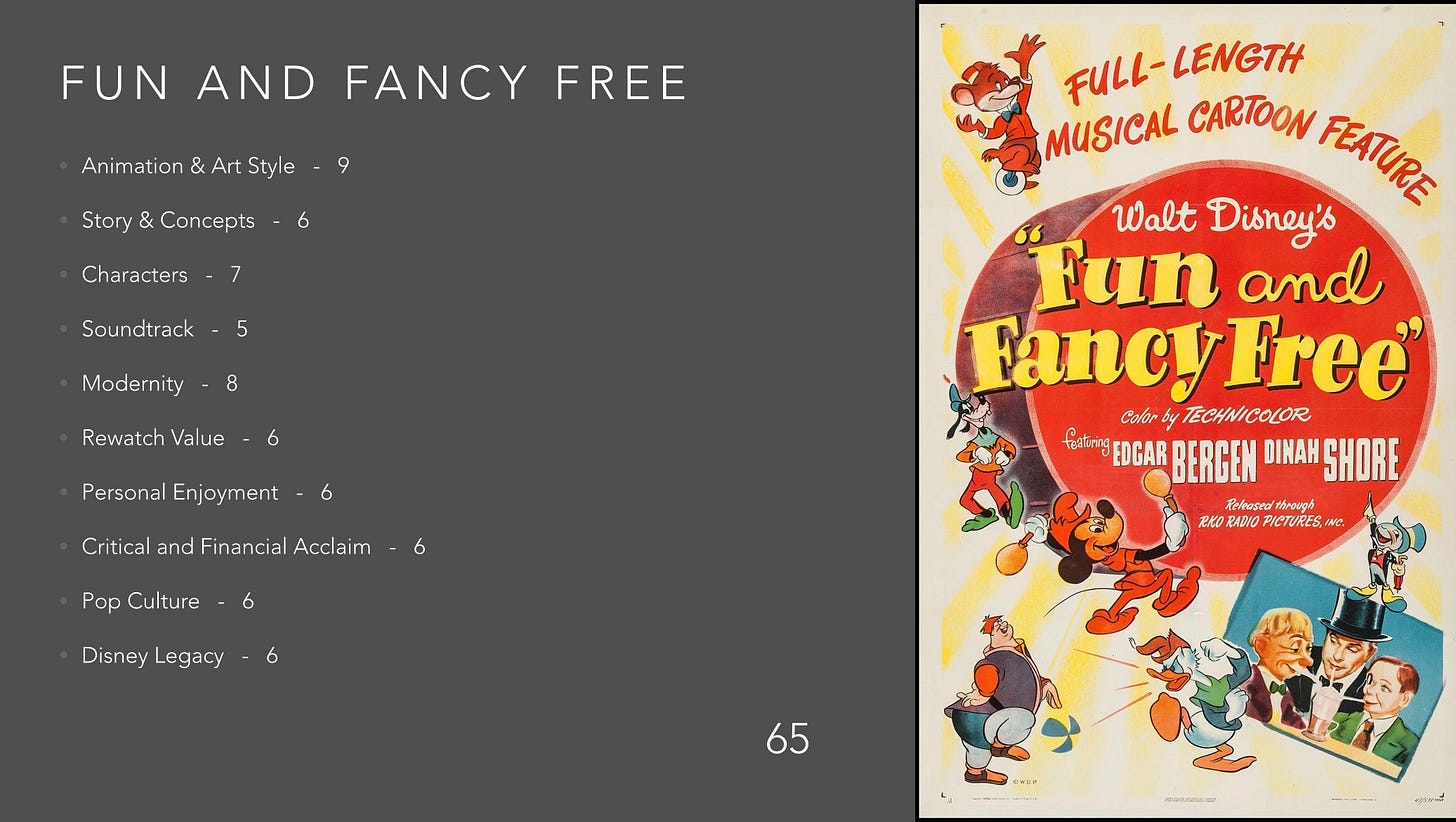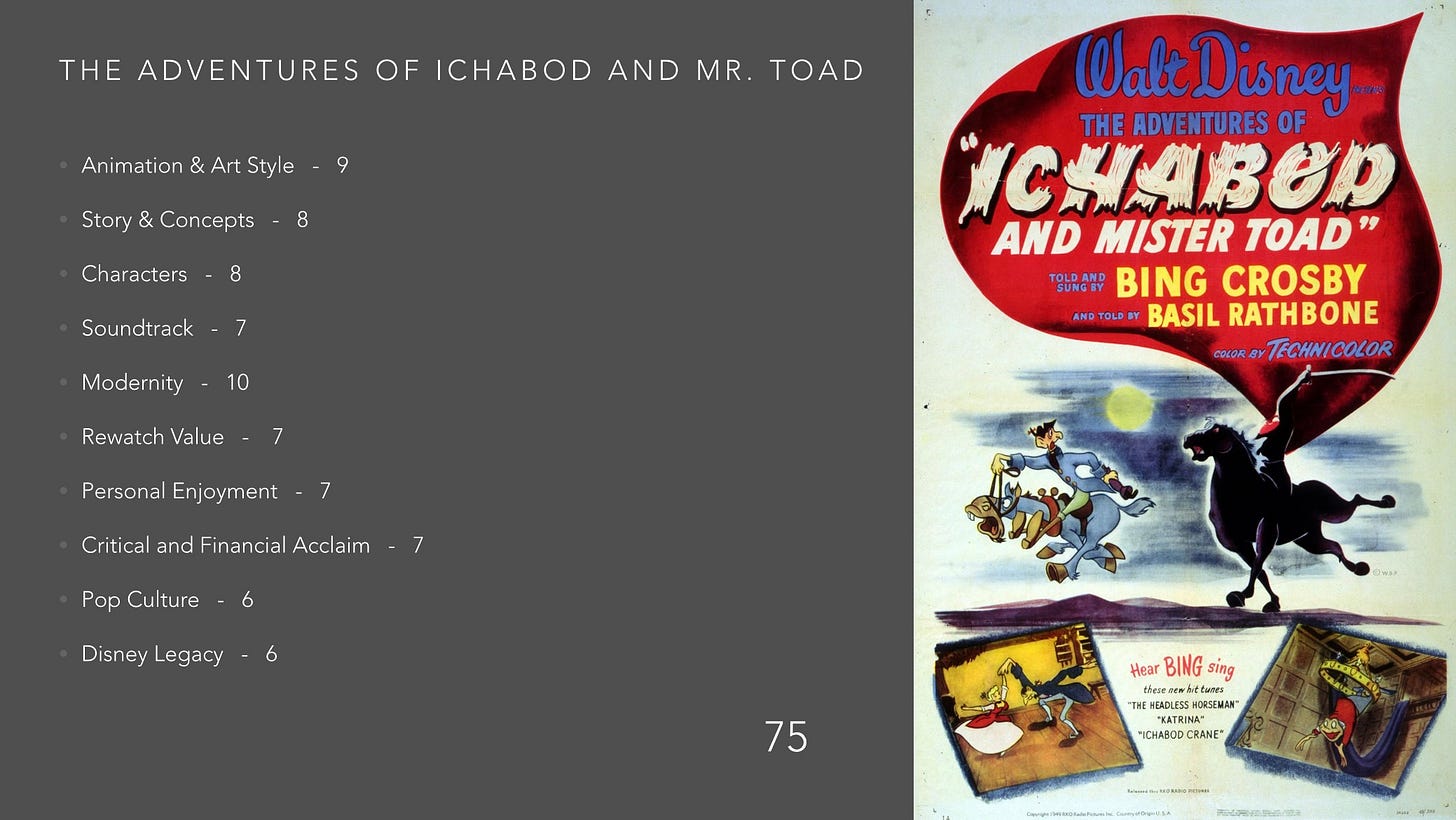Side Vault - The Disney Rankings: The War Era
Don't try to figure out a plan. You can't reason with a headless man.
The War Era
Following the Golden Age of Walt Disney Animation, Walt and his company sat at crossroads. The company had a nasty fight during a strike at the studio, which saw the creator of Goofy leave after nearly getting into a brawl with Walt over the disagreement with the workers’ demands. To make things tougher, Fantasia had left the company in massive debt. Luckily, Dumbo was profitable and help get the company back to normal. But normal wasn’t going to stay, as the world was plunged into the Second World War.
President Franklin Roosevelt made a call to arms for filmmakers to help the United States in messaging. Icons like Frank Capra made films aimed at different groups to convince them to join the war effort. One place the country needed help was Latin America. The area was staying out of the war, but Nazi Germany was making overtures to them in hopes they would join their side and provide problems to the connected United States. The Roosevelt administration gave funding to Walt as part of the FDR Good Neighbor Policy. This would result in Walt falling in love with the region and making films to help showcase the countries in a good light. And while some of it doesn’t age well, it still holds up as a celebration of the cultures of the region.
The War Era goes past the war, as Walt started to do packaged films. This made them easy to make and quick to profit. While this is the most forgotten era in the lineup of Disney Animated Canon films, it’s actually a pretty important one. Donald Duck really becomes a star in this era, Mickey gets to be part of another major moment in a Disney film, experimental animation that was used here would become the norm in the succeeding Silver Age, and Mary Blair (who would go on to become Walt’s stated favorited animator) starts her impact in the company here.
Please look at my Golden Age Rankings article to see how the rankings work and the ratings those consequential films got: Golden Age Disney Rankings
Saludos Amigos (1942)
Saludos Amigos is a film that some Disney fans lowkey really like. I myself see why, as it was one of those movies I saw when me and my brother would stay super late on weekend nights to watch Vault Disney on the Disney Channel, giving me a lot of nostalgia. The movie is exactly what it was meant to be, a good neighbor film to make sure U.S. and Latin American relationships stay on the good side of things during the war.
The film actually ages better than you would think, considering how this region was viewed at the time. The movie also mixes live action and animation in most of the film, which is rare for the Disney animated canon. Outside of the interest to see a piece of the era, this is a movie meant to advertise Latin America and help push Donald Duck to bigger popularity. Once you see it, you don’t need to see it again unless you’re a super fan of Disney animated films like me.
Animation and Art Style - 7
Story and Concepts - 5
Characters - 5
Soundtrack - 4
Modernity - 8
Rewatch Value - 4
Personal Enjoyment - 5
Critical and Financial Acclaim - 5
Pop Culture - 3
Disney Legacy - 4
Final Score - 50
The Three Caballeros (1944)
Much like Saludos Amigos, The Three Caballeros is a film promoting Latin America, specifically Brazil. However, I think this one is a bit better, despite some aspects of the treatment of some women not aging as well. But nevertheless, it is the movie that introduces Donald's group, which has expanded to cartoons and even a theme park ride at Epcot. For the most part, this is a slightly better Saludos Amigos.
Animation and Art Style - 7
Story and Concepts - 5
Characters - 6
Soundtrack - 6
Modernity - 6
Rewatch Value - 5
Personal Enjoyment - 5
Critical and Financial Acclaim - 5
Pop Culture - 5
Disney Legacy - 5
Final Score - 55
Make Mine Music (1946)
The movie that is mysteriously missing from Disney+, making it the only one of the Walt Disney Animated Canon missing from the service, Make Mine Music is arguably the most forgotten Disney film. The best thing about this movie is the animation. It’s the best animation since the Golded Age films, but it’s wasted on a number of packaged cartoons that are mostly forgettable. However, what saves this film is two segments; Peter and the Wolf and The Whale Who Wanted to Sing at the Met.
The Whale Who Wanted to Sing at the Met is famous for the singing whale. I actually really liked and enjoyed watching that segment, and the fact it was last left me feeling a bit better by the end. But, this a movie that can get a bit boring and isn’t going to be on your repeat watch list.
One last note, this movie also showed a pattern that would continue in this era. There are a lot of things here that don’t age. Whether it’s the use of slanderous names for Native Americans or the portrayal of women, these movies overall don’t age well in many cultural departments, just a thing to keep in mind.
Animation and Art Style - 8
Story and Concepts - 7
Characters - 6
Soundtrack - 6
Modernity - 5
Rewatch Value - 4
Personal Enjoyment - 5
Critical and Financial Acclaim - 6
Pop Culture - 3
Disney Legacy - 4
Final Score - 53
Fun and Fancy Free (1947)
This one is actually a bit of a pleasant surprise. While it’s not a movie I’m going to run to watch, this one is kind of enjoyable. The first segment around Bongo the Bear wasn’t my cup of tea and is a bit boring sometimes, but the second half’s Mickey and the Beanstalk steals the show for me. This segment is one of the more iconic things to come out of the era, as the segment itself would be shown as a separate film many times on TV.
You can see the animation and care of details start to come back as the company was getting closer to its Silver Age. Unlike most of its contemporaries, the movie ages well, but today’s generation isn’t going to recognize Edgar Bergen, who makes an appearance in live-action form as was a big star back in the day with his puppets. Being that Mickey has a whole story here and the character of the Giant is still in use today, I made sure to give it an above-average legacy and pop culture score.
Animation and Art Style - 9
Story and Concepts - 6
Characters - 7
Soundtrack - 5
Modernity - 8
Rewatch Value - 6
Personal Enjoyment - 6
Critical and Financial Acclaim - 6
Pop Culture - 6
Disney Legacy - 6
Final Score - 65
Melody Time (1948)
Melody Time is arguably one of the worst-aged films in the Disney lineup. They use the word “redskins” to describe Native Americans. Plus, there’s a scene in the Pecos Bill segment that basically uses a gun to show the symbolism of getting an erection, and no, you didn’t read that wrong it’s in there. But everything else makes up for it when you take the understanding of the film as a piece of its era. The animation is great, the soundtrack is enjoyable, and the characters are memorable, with Pecos Bill getting a quick service restaurant in the parks today.
This is the best of the packaged films when considering all the technicalities and art forms of cinema and animation. I never got bored with any segment and would not mind watching it again. But, the movie’s total ranking has to take a hit due to how badly aged the Pecos Bill segment. While it’s pretty enjoyable, you may think twice before showing a kid before they hit the age of 10 or 11.
Animation and Art Style - 9
Story and Concepts - 7
Characters - 7
Soundtrack - 7
Modernity - 4
Rewatch Value - 6
Personal Enjoyment - 7
Critical and Financial Acclaim - 6
Pop Culture - 3
Disney Legacy - 4
Final Score - 60
The Adventures of Ichabod and Mr. Toad (1949)
This one is a bit of a favorite for me to watch on Halloween Season. The Mr. Toad part of the movie surprised me as I didn’t remember it much from when I saw it as a kid. I found it pretty good, and it had some genuinely funny quotes. The show stealer is the Ichabod part of the movie, based on the Legend of Sleepy Hollow.
None other than the legend himself, Bing Crosby, narrates and sings in the story. That being said, it does take a bit longer than expected to get to the Headless Horseman, and the ending can come off as a bad ending, which I’m never the biggest fan of. But this is the movie I feel is the best movie from the era, just in time, as Disney was going to enter a whole new stratosphere.
Animation and Art Style - 9
Story and Concepts - 8
Characters - 8
Soundtrack - 7
Modernity - 10
Rewatch Value - 7
Personal Enjoyment - 7
Critical and Financial Acclaim - 7
Pop Culture - 6
Disney Legacy - 6
Final Score - 65
Final Thoughts
The War Era is interesting for the company. On one hand, it started due to the need for budget cutbacks and helping with the country’s good neighbor policy. With the government providing funding, they experimented with various ideas and animation techniques that would help them in the future. Plus, the company got its feet back in the driver’s seat and used all the knowledge to launch the important and consequential Silver Age of Disney films. However, the movies are mostly forgettable, and most of them don’t age super great. The mix of live-action sequences that include celebrities who were big at the time but won’t be as well known today isn’t part of the timeless factor that Disney has. Still, you can’t deny that this was an important era for Disney and its animators despite its forgettable nature.
Next, the company goes into the Silver Age and launches films that would be a part of American childhood memories as the post-war Middle Class begins to boom in America. These films would go on to be passed down and are now the heart of classical Disney and important to animation as a whole.
Era Total Rankings
The Adventures of Ichabod and Mr. Toad - 75
Fun and Fancy Free - 65
Melody Time - 60
The Three Caballeros - 55
Make Mine Music - 53
Saludos Amigos - 50

